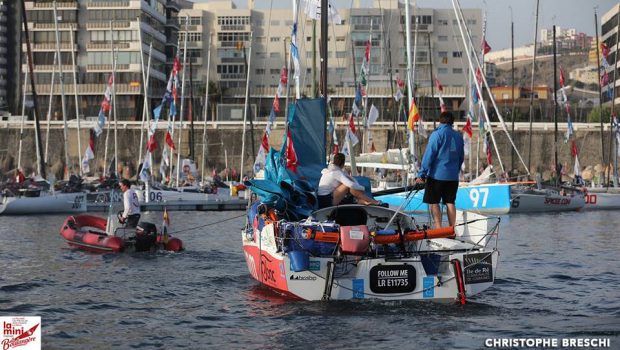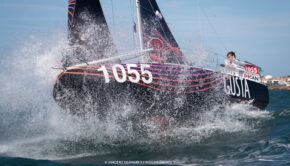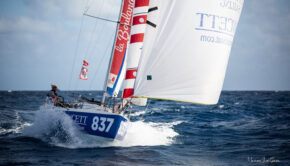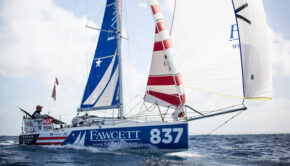Mini Transat: Arrival of the Trades
Published on October 12th, 2017
(October 12, 2017; Day 12) – With light winds delivering the first leg winners of the Mini-Transat La Boulangère to Gran Canaria yesterday, the trade winds now seem to have kicked back in to complete the rankings. With only two retirees from the 81 starters, it is a race now to officially finish, with the solo sailors needing to complete the leg within six days of the winner in their respective category, Prototype or Production.
However, competing in the Mini-Transat doesn’t simply come down to the boat’s position on the scoreboard. It’s a much more personal journey, experienced in an entirely different manner from one skipper to the next, according to their temperaments.
Sometimes, competing in the Mini-Transat is also about accepting that you are going to lose contact with your rivals who, very often, are men and women you have got to know and like over the course of the previous two seasons on the Mini circuit. It’s also about trying to overcome the doubts that inhabit the solo sailor, who only have a limited amount of information about the weather, their position and that of the others, and the weather forecasts.
Some thrive in such situations, discovering another side to their personality that is sometimes very different to their life on shore. Others find a way around the situation, running through possible scenarios throughout the day that might fuel the race, immersing themselves in books that they’ll never get to the end of and establishing routines that will enable them to pass the time.
The second leg begins on November 1, with the solo sailors most often carried along by the trade wind in what tends to be a little over two weeks at sea on average. At this point, there’s no way out: en route to the West Indies, there are no ports of call. The sailors have to rely entirely upon themselves to make Martinique.
Class news – Race news – Tracking – Facebook
Race Facts
· 21st edition
· 4,050 miles to cover between La Rochelle – Las Palmas in Gran Canaria and Le Marin (Martinique)
· 81 skippers at the start
· 10 women
· 11 nationalities
· 20 years: age of the youngest skipper in the race: Erwan Le Draoulec
· 62 years: age of the oldest skipper in the race: Fred Guérin
· 25 prototypes
· 56 production boats
· 66 rookies
· 15 ‘repeat offenders’
Background
With an overall length of 6.50m and a sail area pushed to the extreme at times, the Mini Class offers incredibly seaworthy boats. Subjected to rather draconian righting tests and equipped with reserve buoyancy making them unsinkable, the boats are capable of posting amazing performances in downwind conditions… most often to the detriment of comfort, which is rudimentary to say the least.
The Mini Transat has two legs to carry the fleet from La Rochelle, France to Martinique, West Indies. The leg from La Rochelle to Las Palmas de Gran Canaria is a perfect introduction to proceedings before taking the big transatlantic leap.
The first leg starts on October 1, with the fleet thrust into the Bay of Biscay which can be tricky to negotiate in autumn, while the dreaded rounding of Cape Finisterre on the north-west tip of Spain marks a kind of prequel to the descent along the coast of Portugal. Statistically, this section involves downwind conditions, often coloured by strong winds and heavy seas. Making landfall in the Canaries requires finesse and highly developed strategic know-how.
The second leg begins on November 1, with the solo sailors most often carried along by the trade wind in what tends to be a little over two weeks at sea on average. At this point, there’s no way out: en route to the West Indies, there are no ports of call. The sailors have to rely entirely upon themselves to make Martinique.
Source: Aurélie BARGAT | Effets Mer









 We’ll keep your information safe.
We’ll keep your information safe.